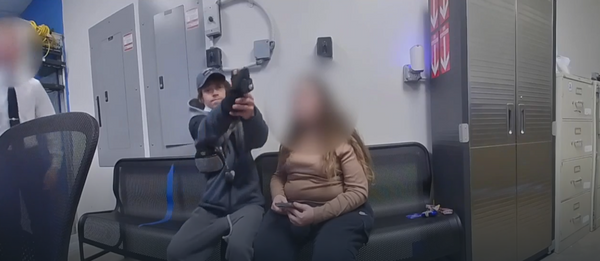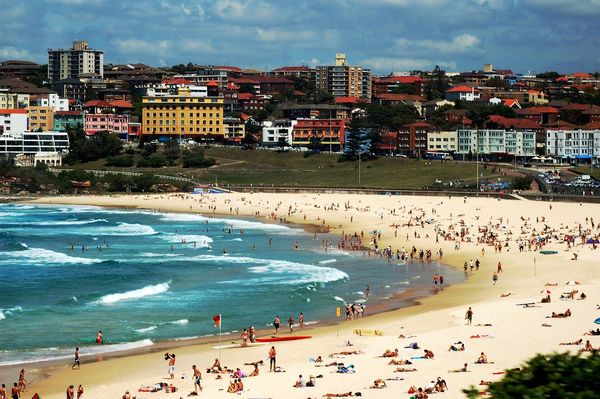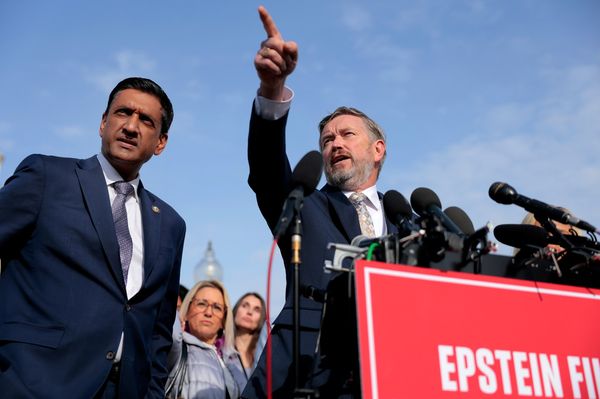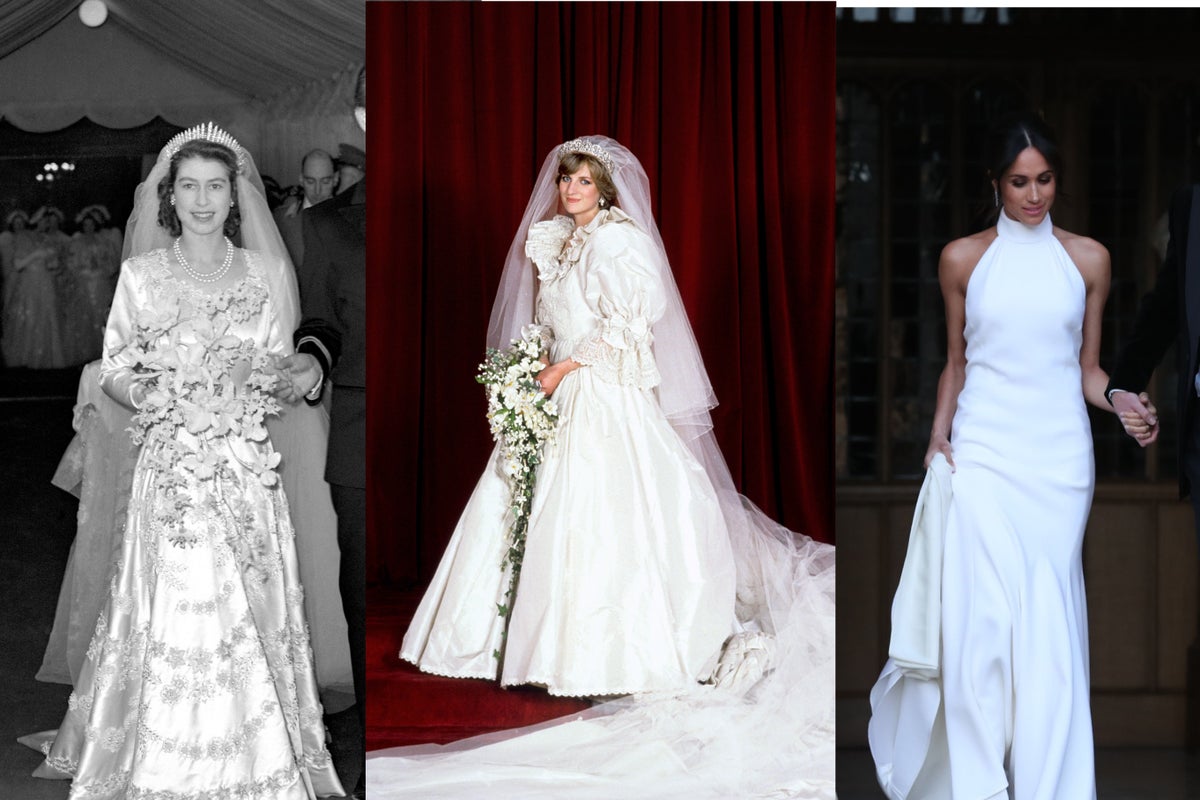
Royal weddings have been captivating the public for years, but the most talked-about part of them always happens to be the bride’s dress.
While royals are known to opt for classic and timeless tailoring, even they are not immune to the influence of trends.
So, here’s a look back at 100 years of royal wedding dress trends starting in the 1920s…
Lord and Lady Mountbatten, 1922
In the Twenties, wedding dress trends had shifted from corseted waists and full skirts (a trend started by Queen Victoria in her 1840 wedding to Prince Albert) to looser, dropped waists and shorter hemlines.
The decade marked a shift toward modernity and liberation post the First World War, and the spirit of the Jazz Age favoured looser, shorter dresses that allowed more freedom of movement.
Edwina Mountbatten, Countess Mountbatten of Burma, married Louis Mountbatten, 1st Earl Mountbatten of Burma and Prince Philip’s uncle, in July 1922.

Lady Mountbatten wore a signature style of the decade, in a round-necked, ankle-length silver satin gown with beaded detailing and a four-foot lace veil.
Queen Elizabeth II and Prince Philip, 1947
The then Princess Elizabeth and Lieutenant Philip Mountbatten married in Westminster Abbey on 20 November, 1947.
Trends of the decade were heavily influenced by the Second World War and simplicity and modesty were key motifs.

Designed by Norman Hartnell, whose signature was said to be embroidery, the dress was made of Chinese silk, with a high heart-shaped neckline, long sleeves, tailored bodice and a 13-foot train.
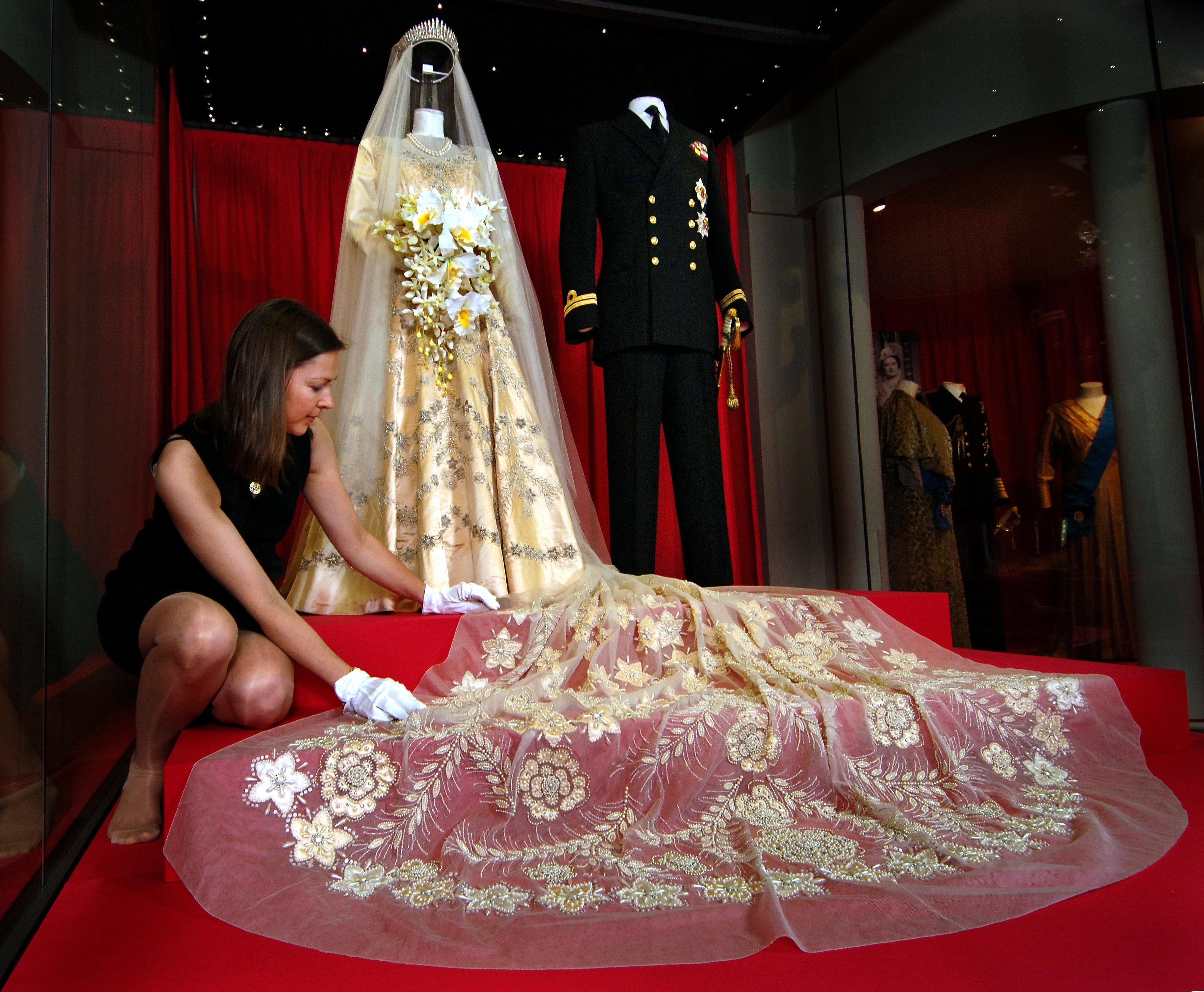
The crystal and pearl embellished train, symbolic of rebirth and growth after the war, was stated to be inspired by Botticelli’s Renaissance painting Primavera, with scattered flowers beginning to bloom.
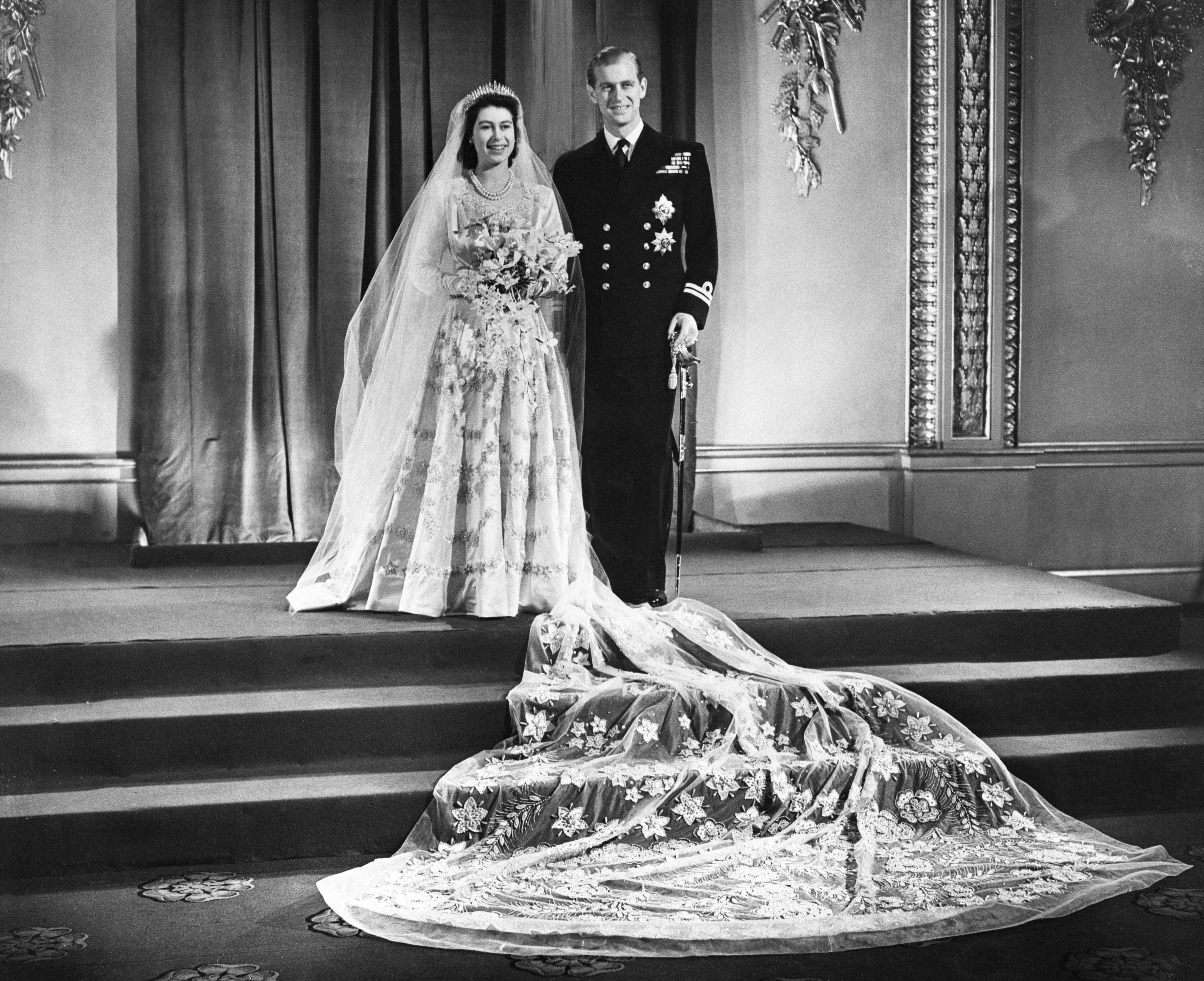
On account of the austerity measures following the war, Princess Elizabeth had to use clothing ration coupons to show her entitlement to the dress.
The government allowed her 200 extra ration coupons, but she was also given hundreds of clothing coupons by brides-to-be from all parts of the country to help her acquire the dress. However, she returned the coupons to the brides and declined to use them.
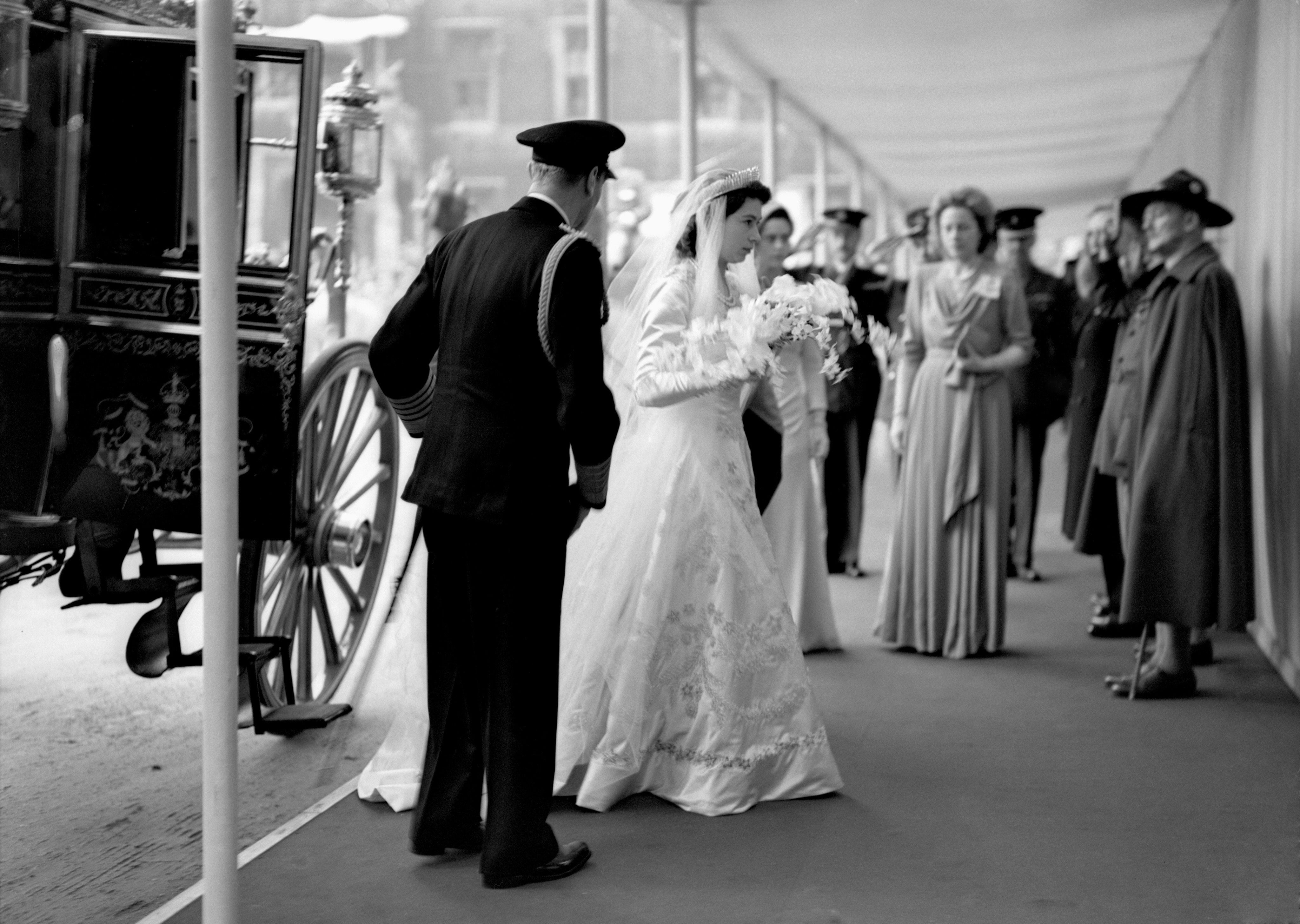
Princess Margaret and Lord Snowdon, 1960
By the 1960s, minimalism and monochrome pervaded fashion.
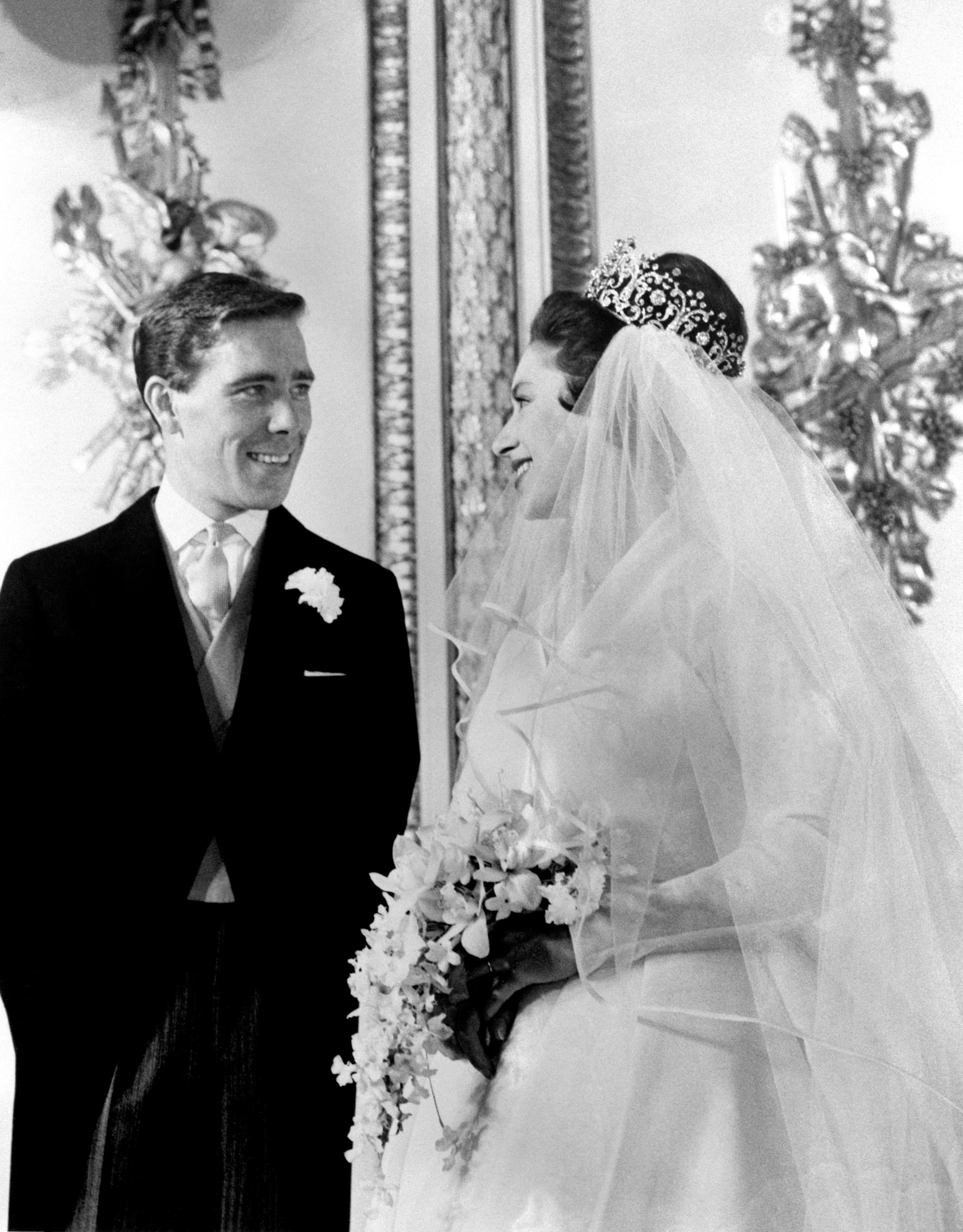
So when Princess Margaret married British photographer Antony Armstrong-Jones at Westminster Abbey in May 1960; she wore an unfussy, fit-and-flare gown by Norman Hartnell, the same designer as her sister’s.
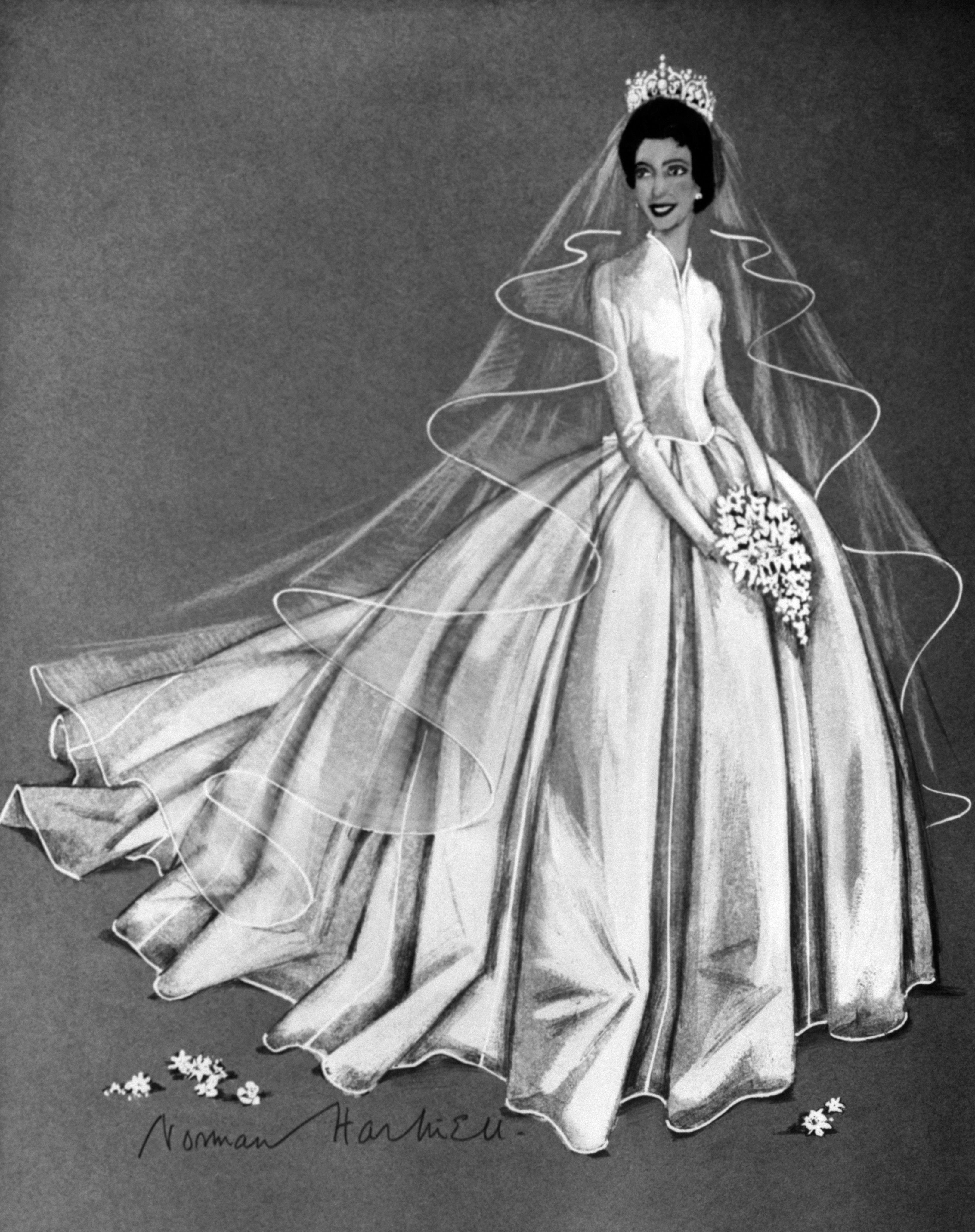
The dress was refreshingly modern and featured no embroidery or motifs on the gown or veil.
Princess Anne and Captain Mark Phillips, 1973
Princess Anne married British equestrian Mark Phillips at Westminster Abbey in November 1973.
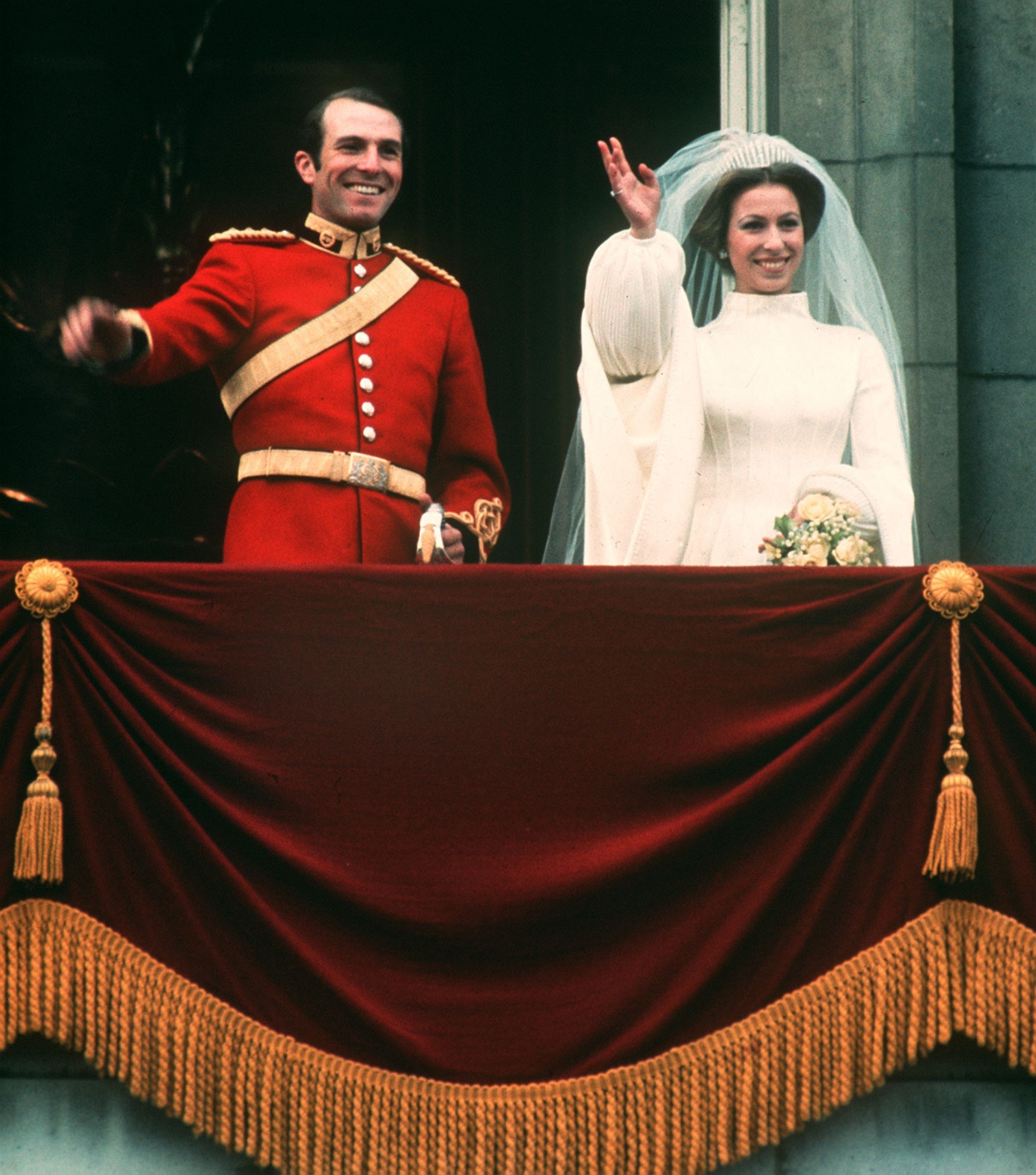
Designed by Maureen Baker, Princess Anne wore a Tudor-inspired gown with a high collar and trumpet sleeves.
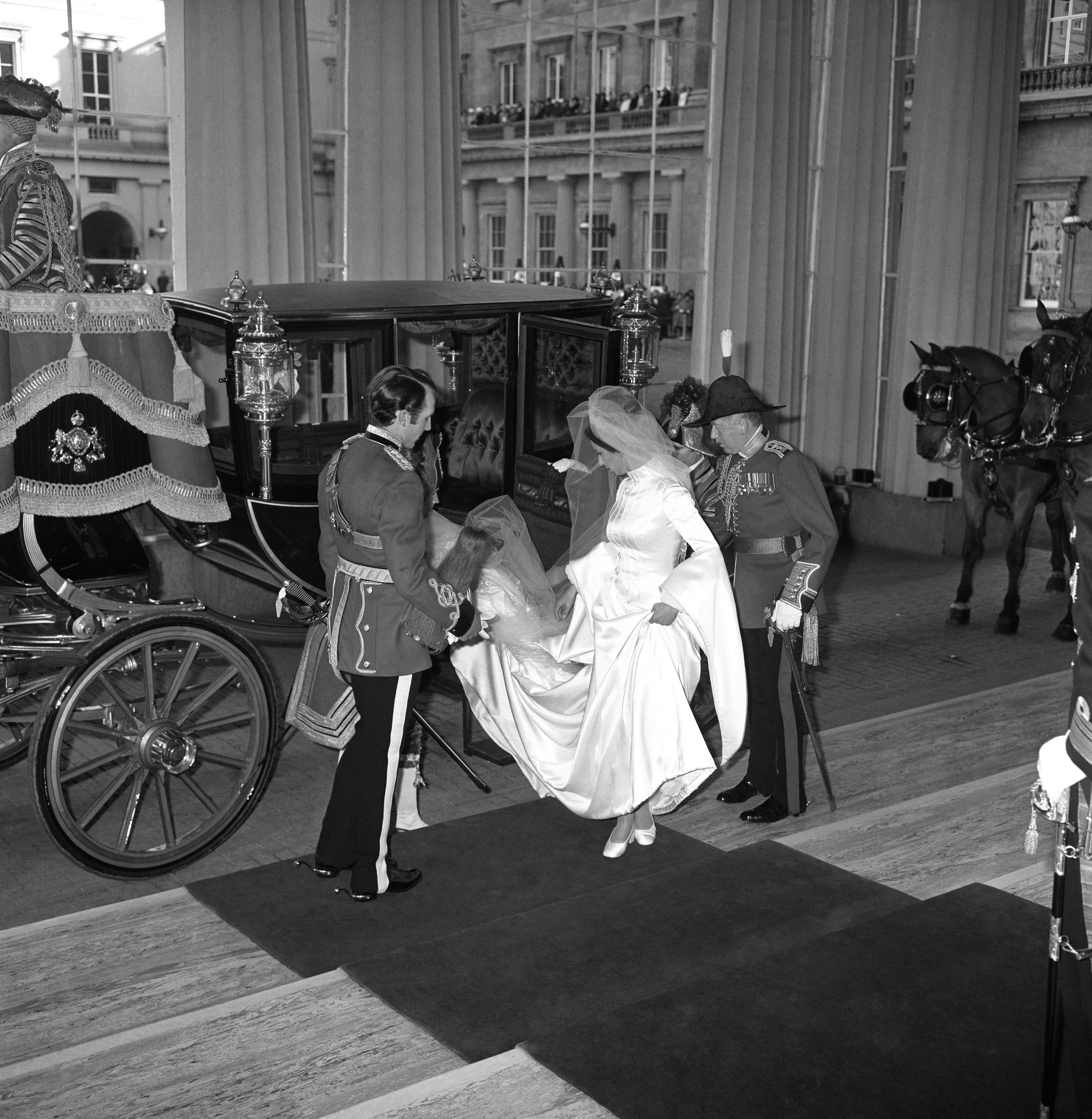
In contrast to earlier royal bridal gowns, it was considered “simplistic” and closely aligned with the contemporary wedding styles of the Seventies.
Prince Charles and Princess Diana, 1981
Diana, Princess of Wales’ 1981 wedding dress epitomised the opulence and romanticism of early Eighties bridal fashion.
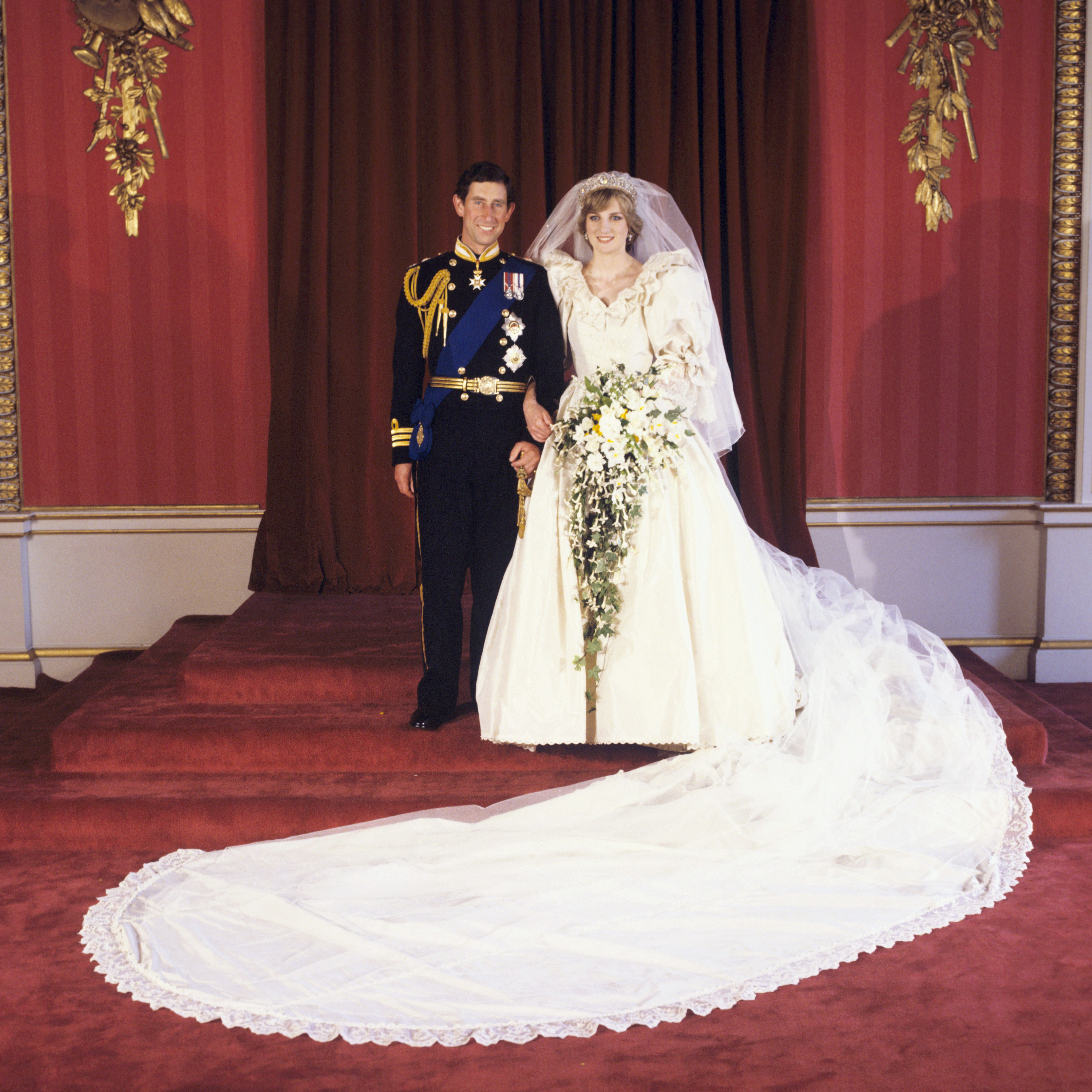
Designed by David and Elizabeth Emanuel, the gown featured exaggerated puffed sleeves, a full skirt, intricate lace detailing and a record-breaking 25-foot train – perfectly capturing the era’s love for drama and grandeur.
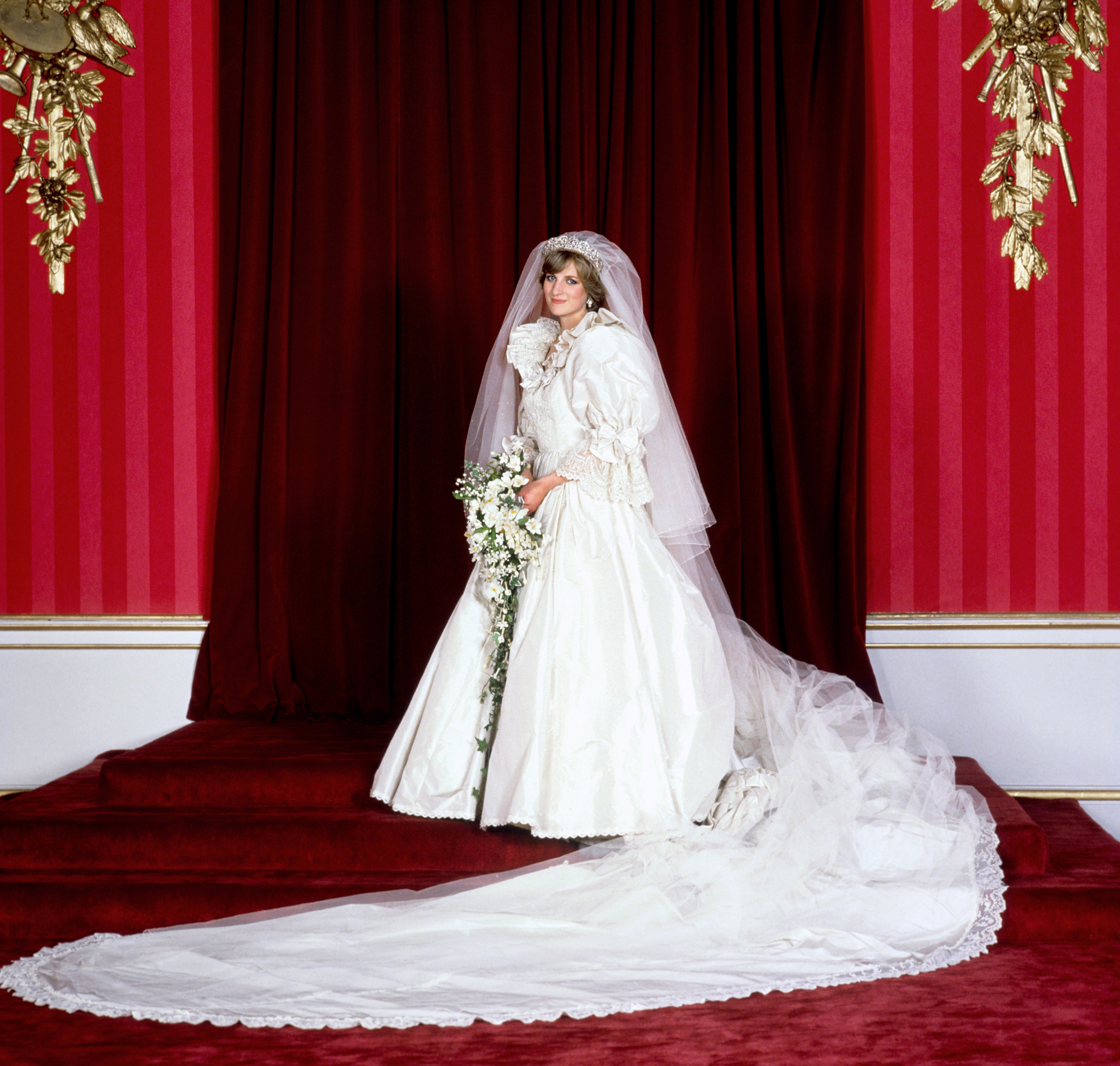
Made out of silk taffeta and antique Carrickmacross Irish lace, the gown famously wrinkled as she stepped out of the carriage at St Paul’s Cathedral.
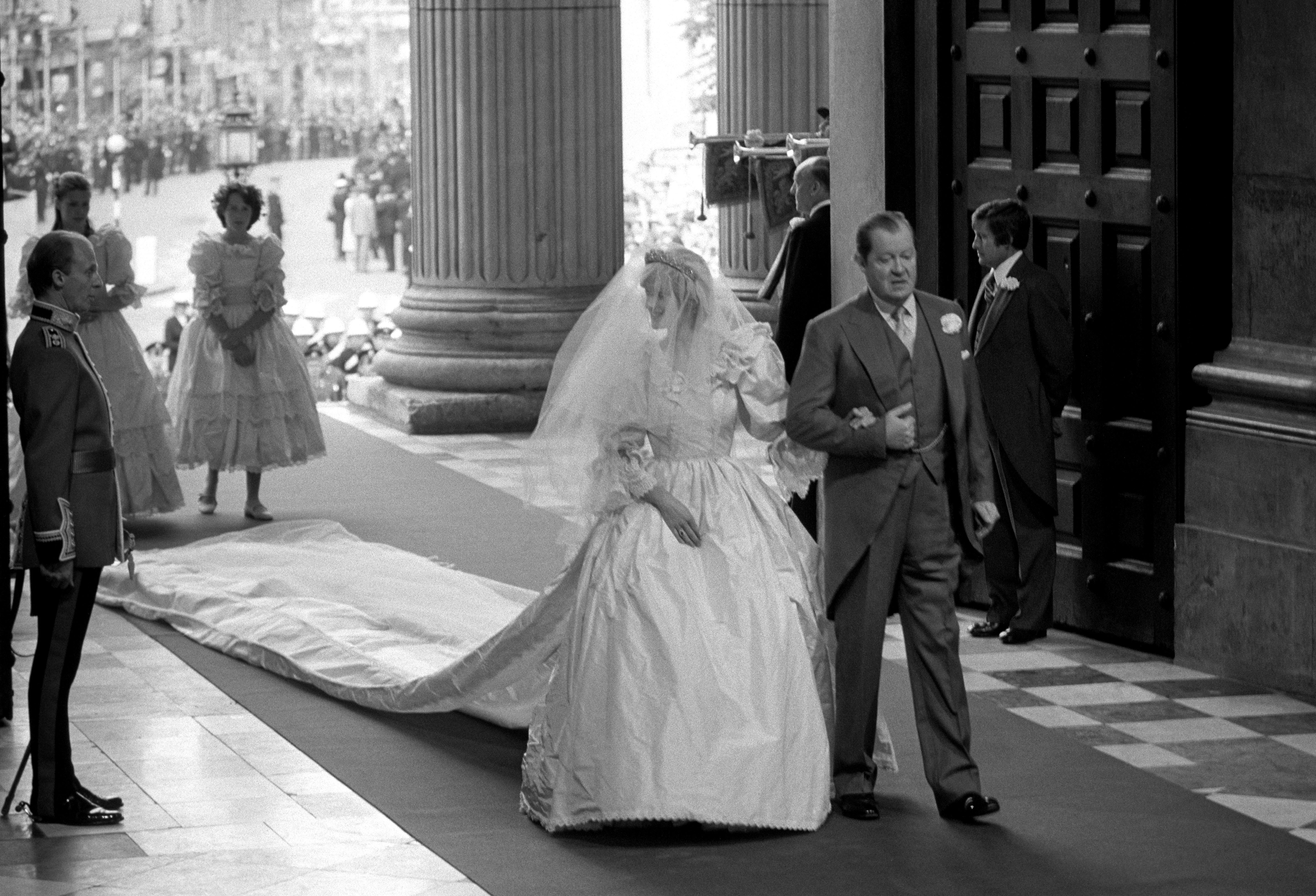
Its fairy-tale silhouette sparked a wave of copycat styles, setting the tone for wedding fashion throughout the decade and cementing Diana as a (bridal) style icon.
Prince Andrew and Sarah Ferguson, 1986
Prince Andrew married Sarah Ferguson at Westminster Abbey in 1986.
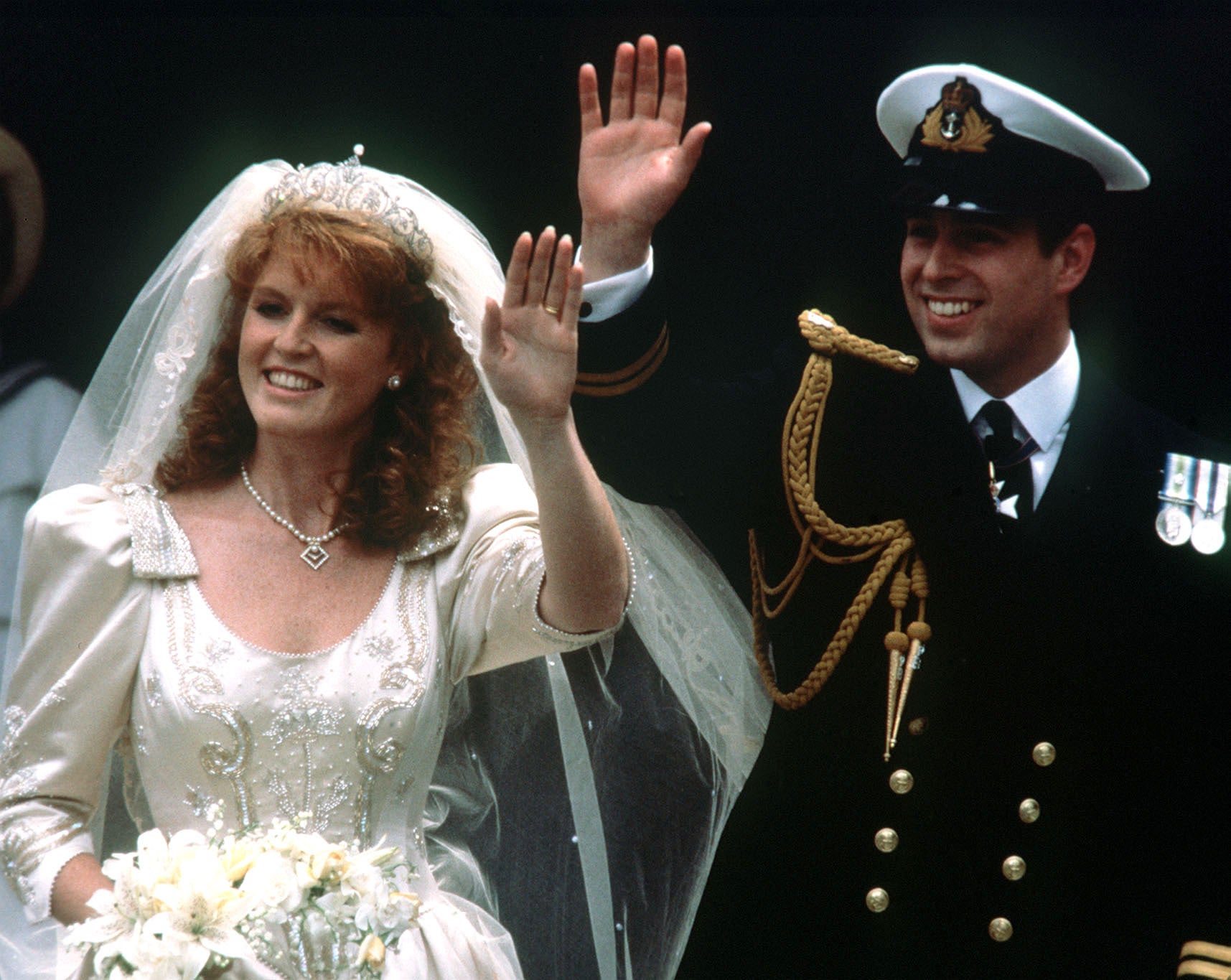
Ferguson’s dress was designed by Lindka Cierach in ivory duchess satin, it featured a fitted bodice, full skirt and intricate beadwork, including motifs like anchors and waves representing Prince Andrew’s sailing background and bumblebees and thistles, which were taken from Ferguson’s family heraldry.
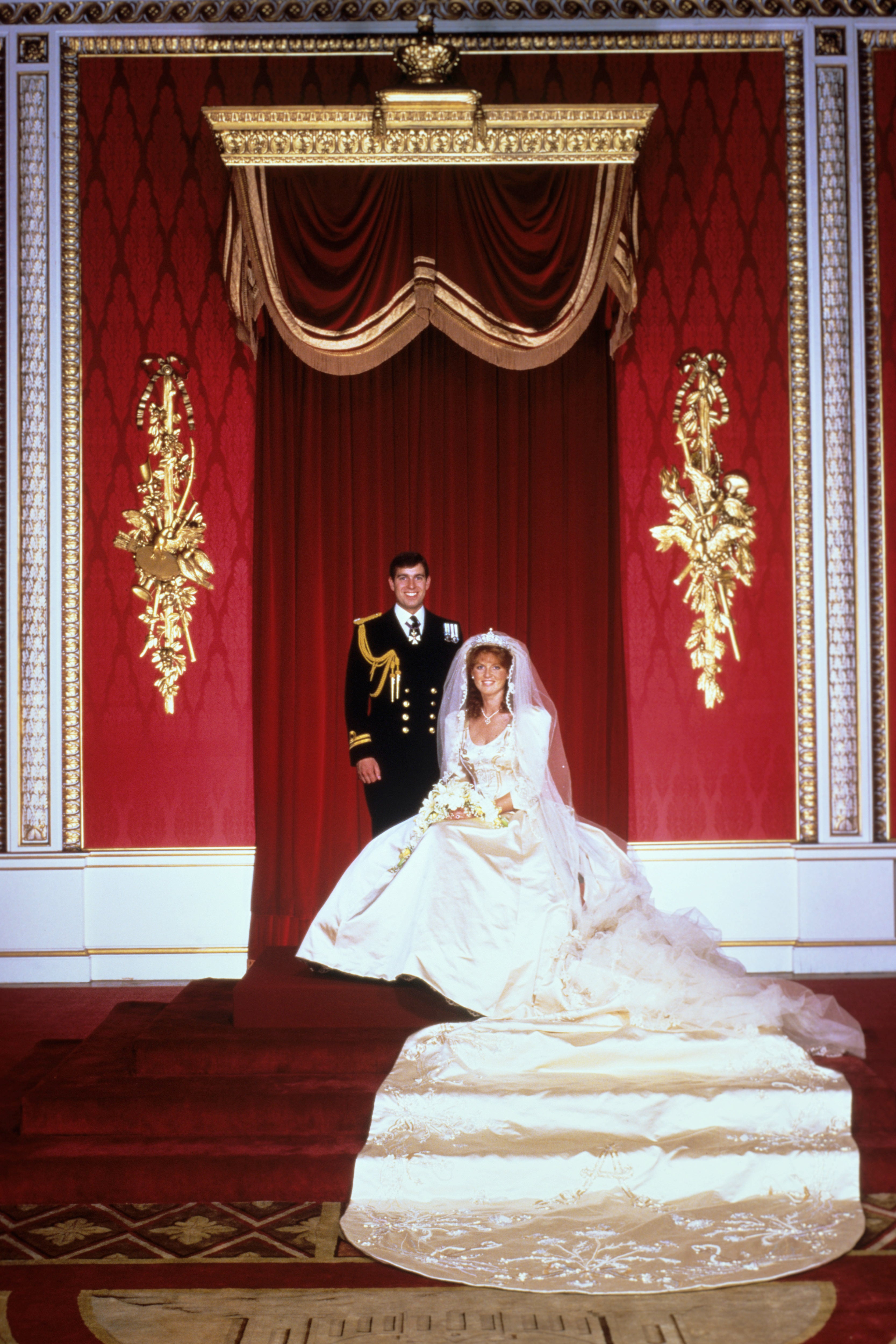
The dramatic 17-foot train and heart-shaped neckline echoed the romantic, voluminous styles popular in the Eighties.
Lady Sarah Armstrong-Jones and Daniel Chatto, 1994
Lady Sarah Armstrong-Jones, daughter of Princess Margaret, married actor Daniel Chatto in St Stephen Walbrook Church in London, in July 1994.
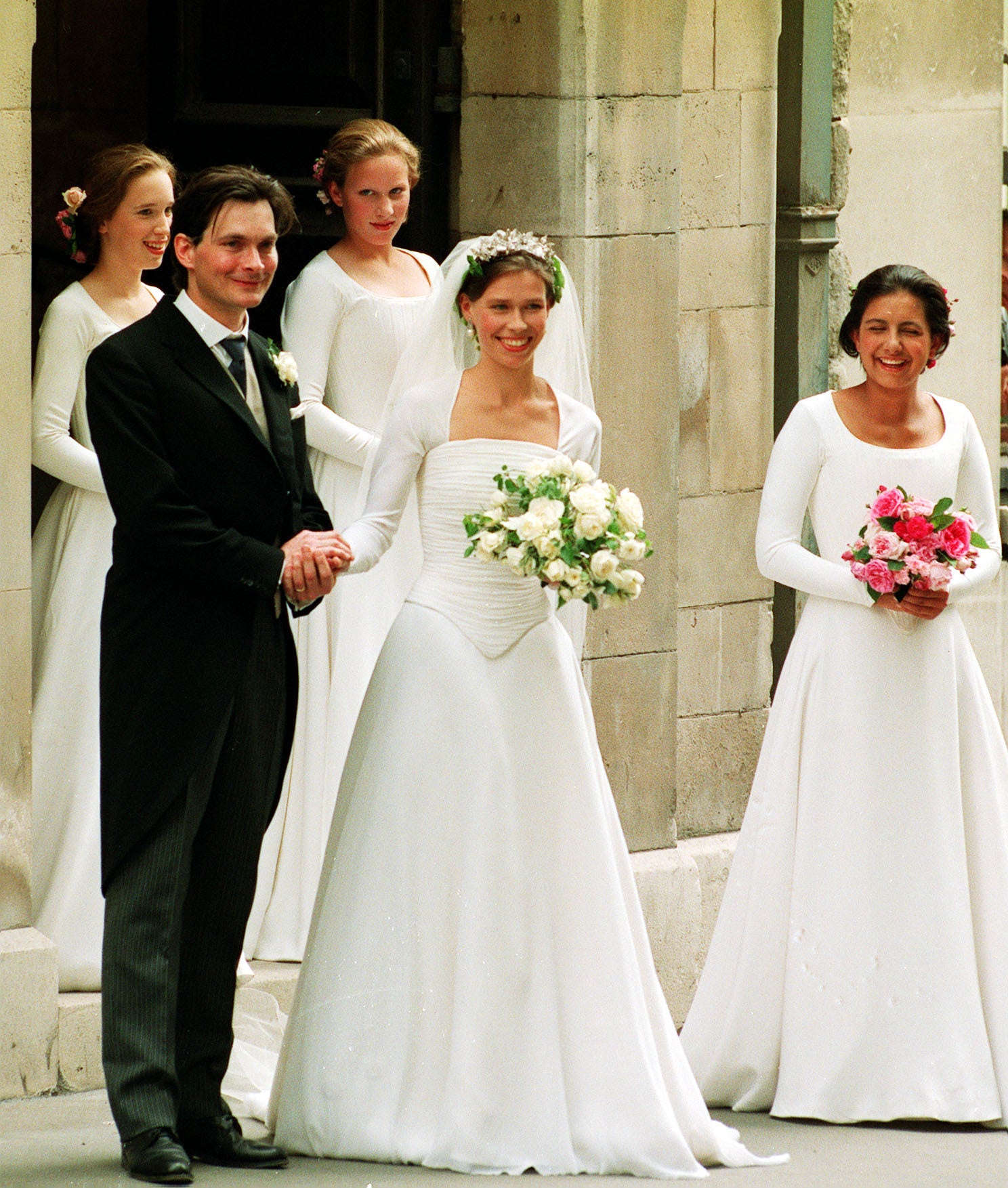
Sarah wore a square-necked, Basque-waist Jasper Conran dress with long sleeves – two trends that are currently coming back into fashion this season.
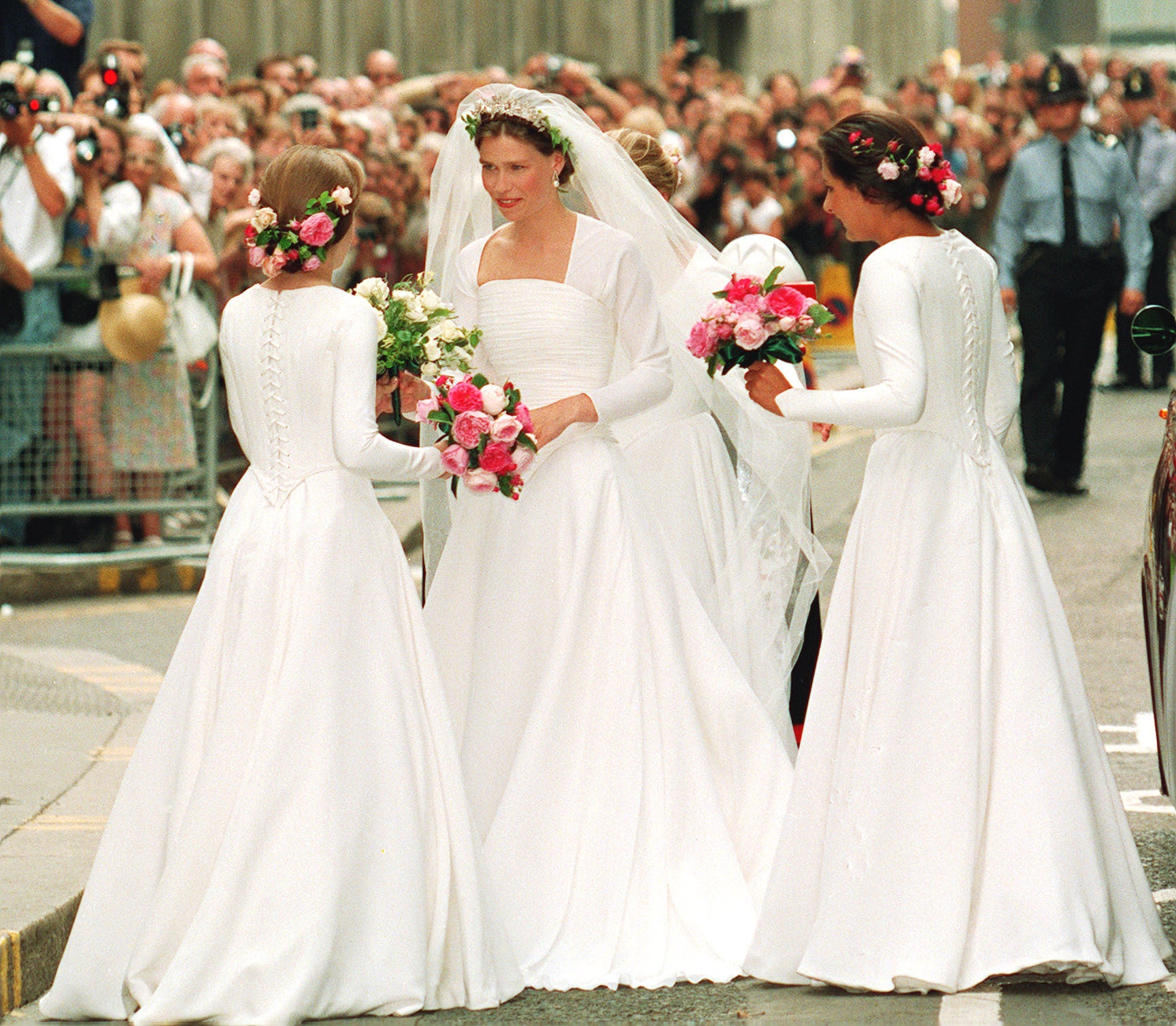
Made from ivory silk crepe, its simplicity and timeless cut stood out for its quiet sophistication, echoing the Nineties move towards pared-back bridal fashion.
Prince Edward and Sophie Rhys-Jones, 1999
When the late Queen’s youngest son Prince Edward married public relations executive Sophie Rhys-Jones in June 1999, she wore a simple, long-sleeved gown by Samantha Shaw.
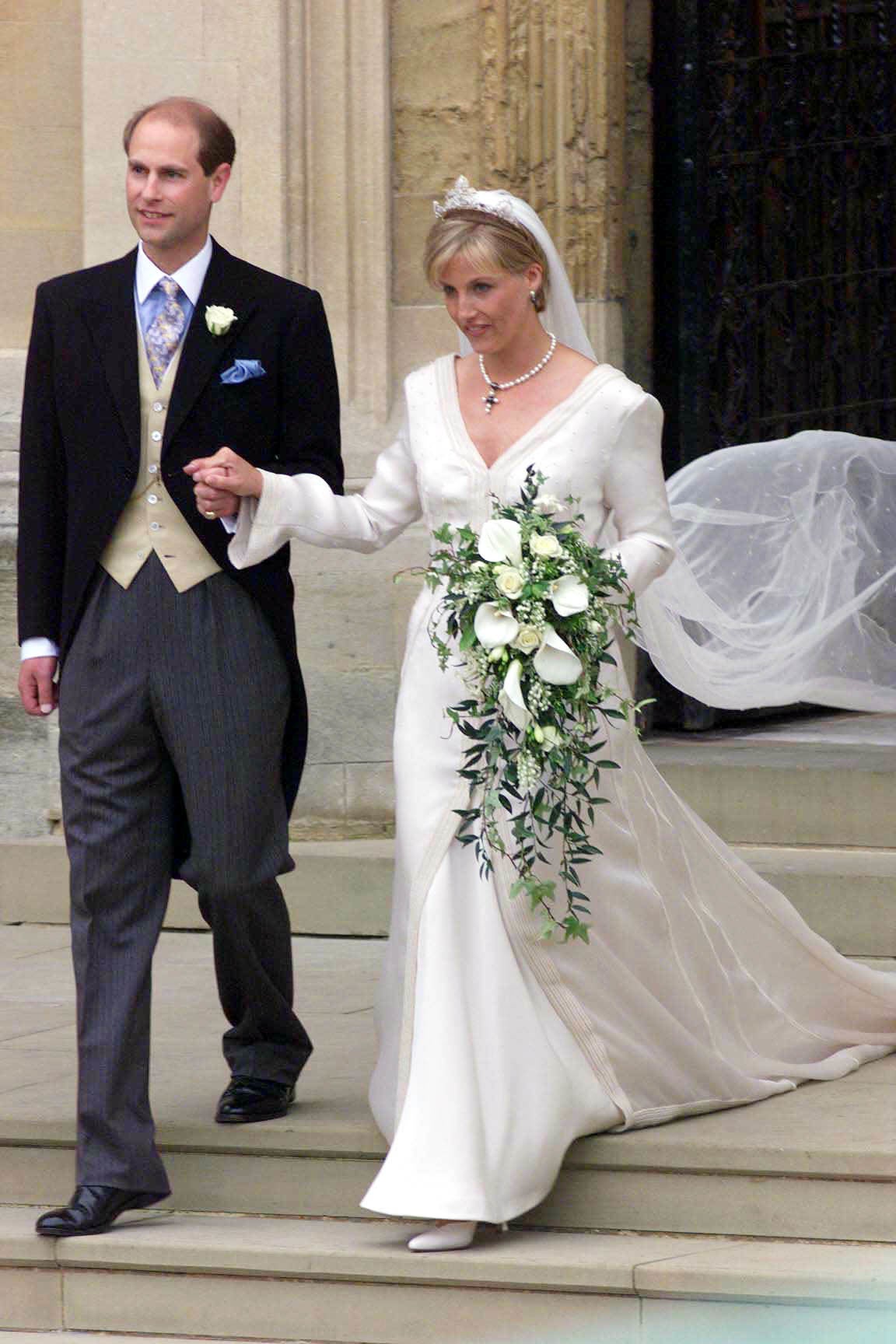
The now Duchess of Edinburgh’s gown was crafted from hand-dyed silk organza and embellished with over 325,000 pearls and crystal beads and featured a full-length coat-style overlay with a subtle V-neckline.
The style balanced traditional royal formality with the sleek, streamlined silhouettes that were gaining more popular at the turn of the millennium.
Prince William and Catherine Middleton, 2011
When the then Catherine Middleton married Prince William on April 29 2011 at Westminster Abbey, she wore an A-line lace dress by the British designer Sarah Burton for Alexander McQueen.

The now Princess of Wales, wanted a wedding gown that combined “tradition and modernity with the artistic vision that characterises Alexander McQueen’s work”, the Palace said at the time.
Much like the late Queen’s wedding dress, Kate’s gown was embroidered with the rose, the thistle, the daffodil and the shamrock, to represent each of the four countries that make up the United Kingdom.
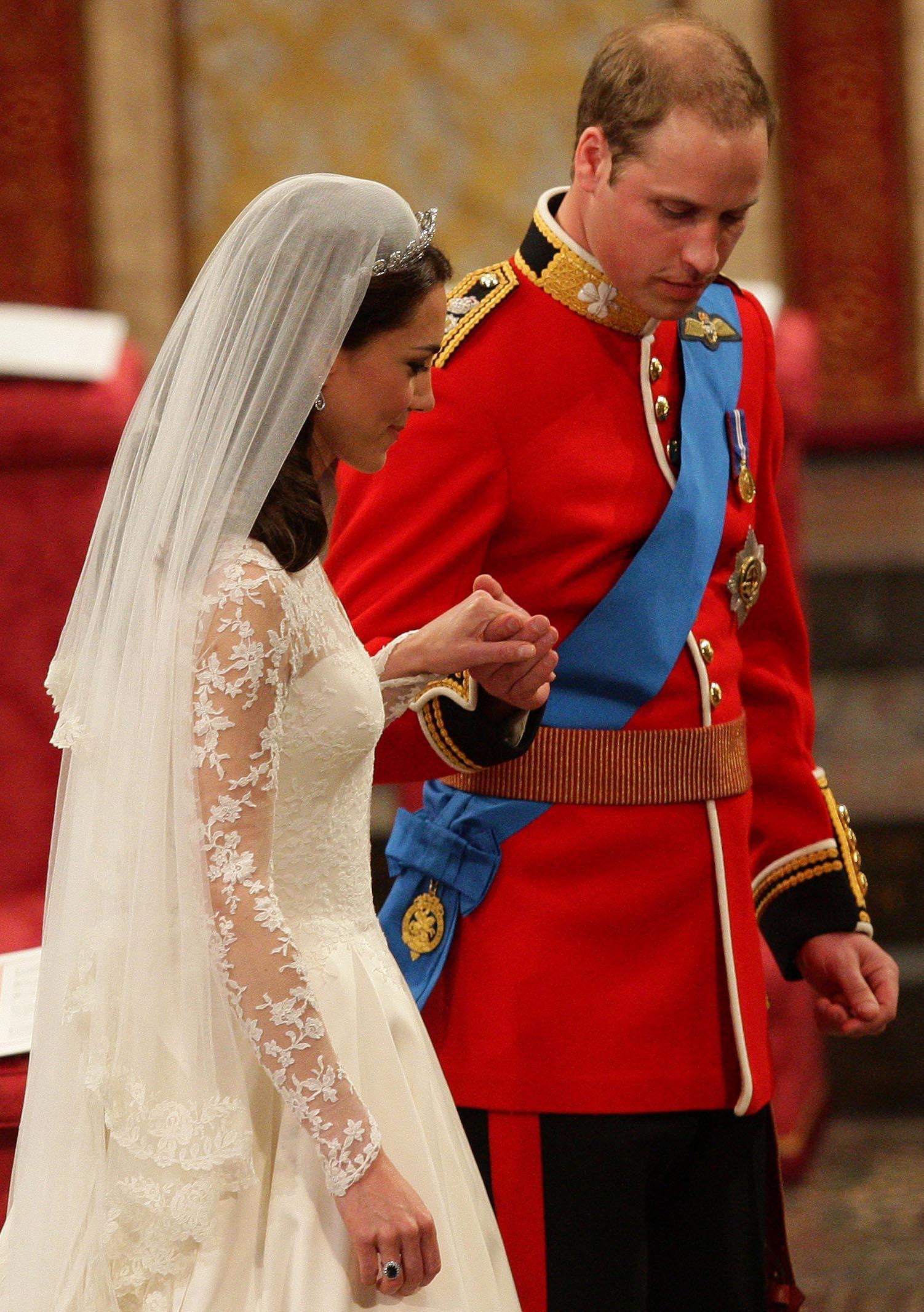
The dress sparked a global resurgence in interest for modest, lace-sleeved gowns with structured silhouettes – marking a shift away from strapless or heavily embellished styles that had dominated the early 2000s.
Designers and bridal brands quickly embraced the “Kate effect,” with replicas and inspired styles appearing across collections worldwide.
Prince Harry and Meghan Markle, 2018
Prince Harry married American actress Meghan Markle in May 2018 at St George’s Chapel, in Windsor Castle.
Meghan wore a Givenchy gown by British designer Clare Waight Keller, the French fashion house’s first female artistic director. The pure white, bateau-neck dress featured clean lines, a sculpted silhouette and three-quarter-length sleeves, offering a sharp contrast to more embellished royal bridal styles.
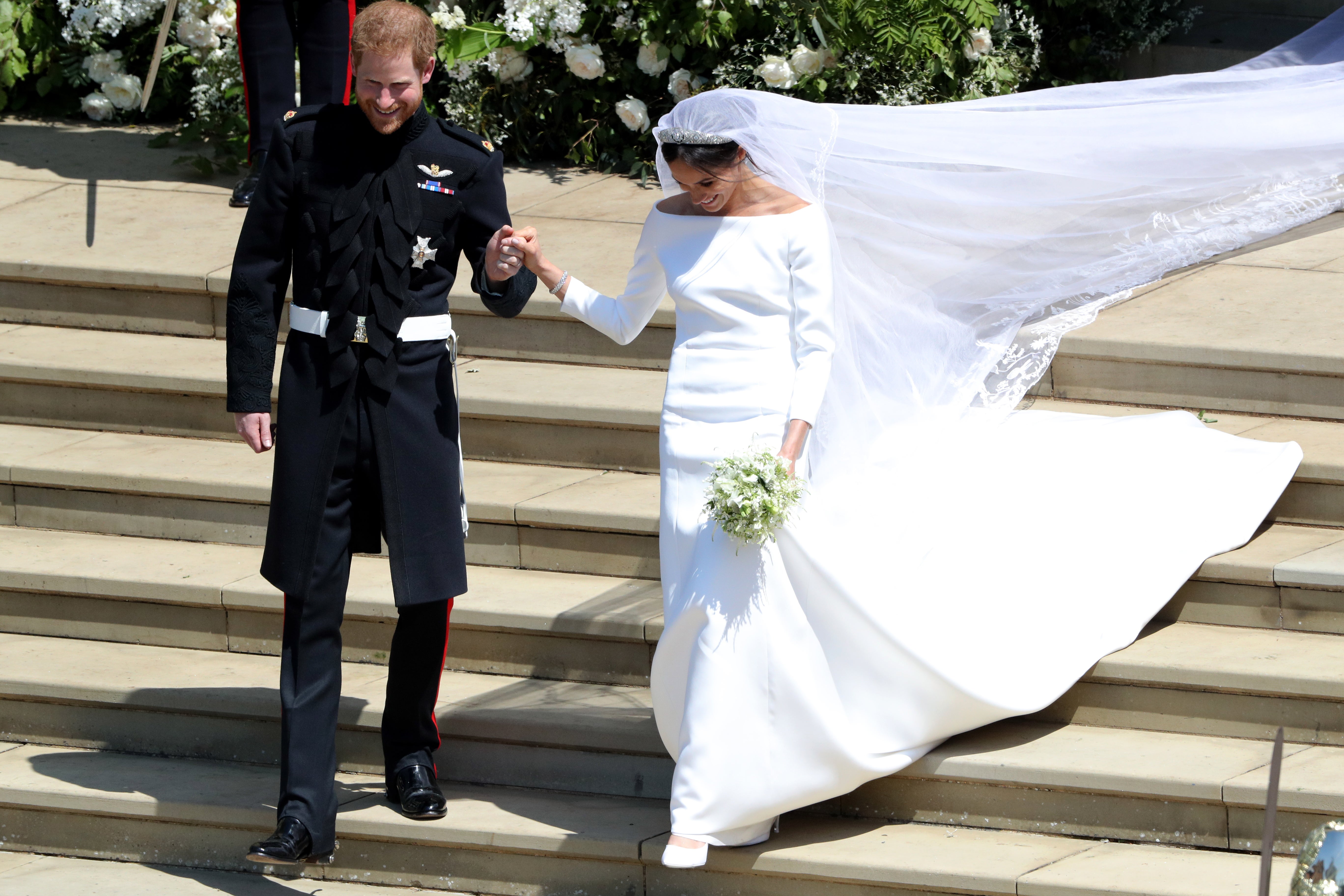
The dress was widely praised for its understated elegance and symbolic simplicity and leant into the ‘quiet luxury’ bridal trends of the late 2010s.
Just as memorable as this gown was Meghan’s second wedding dress, which was a custom Stella McCartney halter-neck gown. It sparked a big trend for two-dress weddings among brides.
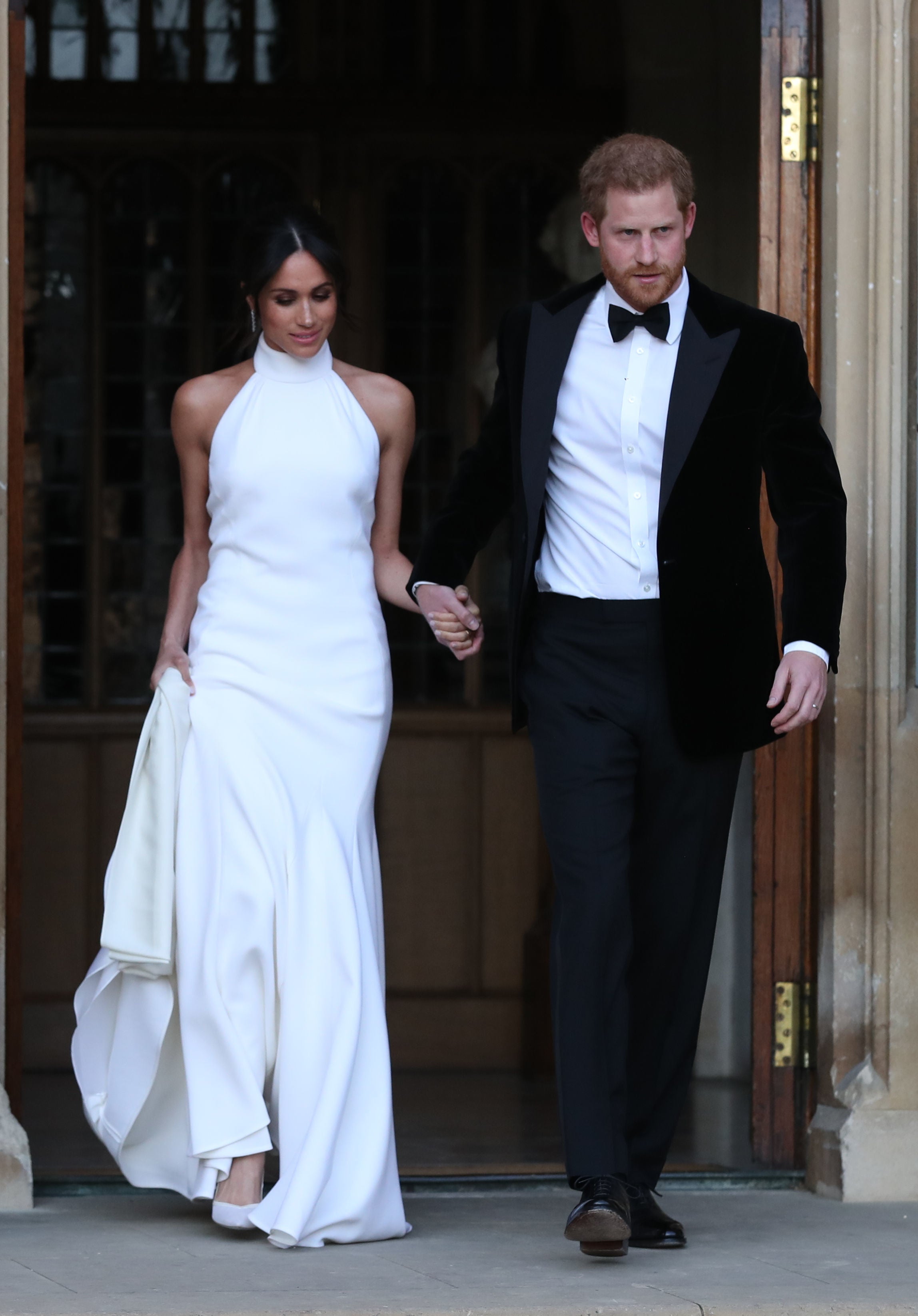
Princess Eugenie and Jack Brooksbank, 2018
For Princess Eugenie’s autumnal wedding to British marketing executive Jack Brooksbank in October 2018, she wore a long-sleeved A-line gown designed by Peter Pilotto and Christopher De Vos.

The fitted dress featured a wide neckline, folded shoulders and a low back – a deliberate choice to reveal the scar from her childhood scoliosis surgery.
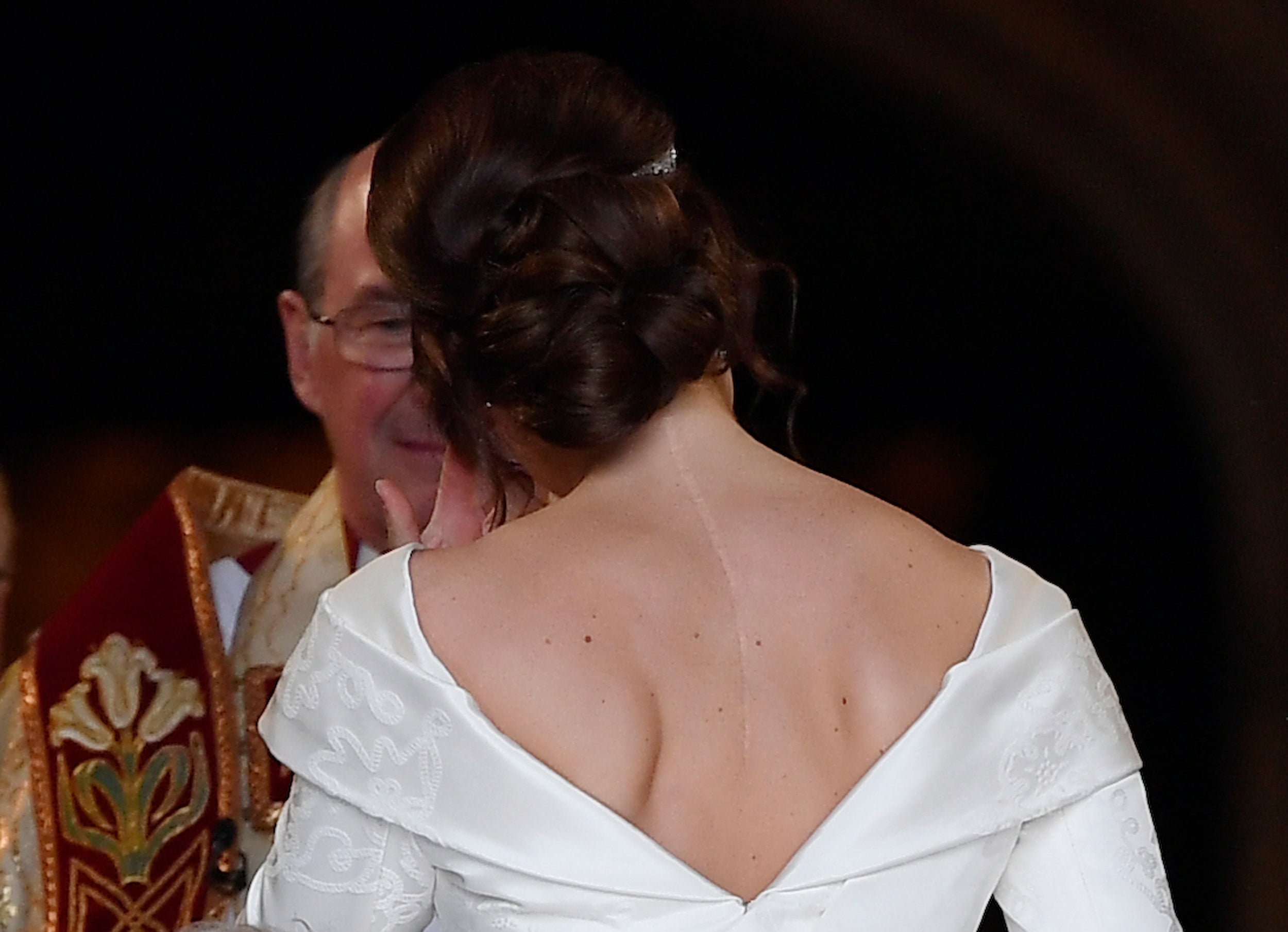
Made from a jacquard of symbols, including a Scottish thistle, to show the couple’s fondness for Balmoral, an Irish shamrock, a nod to the bride’s maternal family, a York Rose, a reference to her family name of York and ivy, which represented the Ivy Cottage, the couple’s home at Kensington Palace.
Princess Beatrice and Edoardo Mapelli Mozzi, 2020
Princess Beatrice’s wedding dress was truly a sign of the times – a nostalgic nod to happier moments as she married British property developer Edoardo Mapelli Mozzi mid-pandemic in July 2020, at the Royal Chapel of All Saints at Royal Lodge, Windsor.
Beatrice wore a vintage Norman Hartnell gown originally designed in the 1960s and previously worn by her grandmother, Queen Elizabeth II.
The dress was remodelled with organza puffed sleeves and a satin hem to suit Beatrice’s style.
The decision to wear a repurposed dress not only reflected the intimate and understated nature of her ceremony but also resonated with the decade’s growing interest in sustainable fashion.


